|
Three years later, Amelia taught at the Navajo Preparatory School in Farmington, NM. She taught at the college level to advanced Navajos of art. But at this preparatory school every student was required to take four years of art in order to graduate.
Finally, Amelia decided to go back to college to get her masters degree in art education with a specialty in Metal-smithing and Jewelry Design from Indiana University. It was at Indiana University where Amelia met Randy Long, Professor of Metal-smithing. Though Amelia entered school for the purpose of gaining her masters in art education, she already had ideas of using her silverwork as a means of making a living. Amelia had gotten weary of trying to get the idea across that art is a cultural way of life, rather than an activity, and decided to employ her artistic talents to support herself instead of teaching.
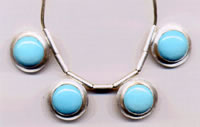 With
Professor Randy Long, Amelia learned about metal smithing and about
the business side of art. She realized that she didn’t have
to be stuck in her native artistic traditions, and that metal smithing
was the only area that she could go contemporary without stepping
on traditional taboos. It was a safe medium to break through and
express her contemporary ideas without losing the traditional ties
that she valued. Amelia also likes to paint and sketch. But painting
and sketching are areas that you cannot show certain aspects or
“too much” out of respect for her culture. Wherever she
goes, Amelia takes her sketch pad with her as those sketches come
in handy when designing her jewelry. Amelia also takes a lot of
her philosophical ideas about living and uses them in her designs.
With
Professor Randy Long, Amelia learned about metal smithing and about
the business side of art. She realized that she didn’t have
to be stuck in her native artistic traditions, and that metal smithing
was the only area that she could go contemporary without stepping
on traditional taboos. It was a safe medium to break through and
express her contemporary ideas without losing the traditional ties
that she valued. Amelia also likes to paint and sketch. But painting
and sketching are areas that you cannot show certain aspects or
“too much” out of respect for her culture. Wherever she
goes, Amelia takes her sketch pad with her as those sketches come
in handy when designing her jewelry. Amelia also takes a lot of
her philosophical ideas about living and uses them in her designs.“I never go into the studio if I’m angry, or upset because the energy gets into your work,” says Amelia. “When I do go to the studio, I’m always in a good mood. I love the feel of the metal and stones, and try to create from “Hózhó” to ‘walk in beauty.’ Like my grandfather told me; you have to get up every morning and balance everything in your life. When I create, it’s out of goodness. Then whoever buys one of my pieces, is attracted, in part, to that goodness. It becomes a connection of goodness. Usually people say they buy a particular piece because it spoke to them in some way and they feel good when they put it on. I may not make more than one sale in a 3 day show except to make a connection for just that one person that was looking for just that kind of piece. My art has become a teaching tool aboutr the Navajo culture; a culture I tried to run away from for a long time.”
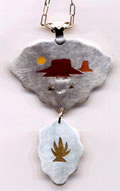 Amelia
and I spoke about the reasons behind her wanting to run from her
culture and why she returned. “I didn’t want to raise
my Mom’s kids. I am the oldest, so taking care of 6 brothers
and 4 sisters is just part of a way of life on the reservation.
I didn’t want to stay in one spot all my life and then raise
my own kids. I could have made a living, since silver workers are
common on the reservation. Everyone has one in their family, but
then others in my family would rely on my earnings to help support
them, which is also part of our culture. There is also a lot of
physical labor involved with making a farm and getting water since
there isn’t any running water on the reservation. I was lucky
that I had to leave the reservation to finish high school. Then
you go home and wonder ‘why am I here?’ My parents were
the generation of the “boarding school” when the government
bussed everyone to different schools and so they were dispersed
throughout the country. My parents don’t really understand
what I do. I’ve lived in African American neighborhoods, Hispanic
neighborhoods, all kinds of ethnic neighborhoods where I was the
only Navajo. Being aware of all of that, you kind of become a chameleon
between home and the outside world. A lot of Navajos that leave
the reservation go back because it’s really difficult trying
to deal with the prejudice. You learn to walk between two worlds.
So, when I go home, I’m quieter, more reserved. In galleries,
I have to talk about my work, which is considered bragging and unacceptable
at home. Through all of it, my artwork is what has sustained me.
It got me to do things I wouldn’t have done otherwise, like
travel or go to remote places to sketch. I’ve never been separate
from my artwork. Now, I like going home, especially to be part of
the ceremonies. They inspire me and reinforce how much we are a
part of the earth. It makes you feel good about who you are.
Amelia
and I spoke about the reasons behind her wanting to run from her
culture and why she returned. “I didn’t want to raise
my Mom’s kids. I am the oldest, so taking care of 6 brothers
and 4 sisters is just part of a way of life on the reservation.
I didn’t want to stay in one spot all my life and then raise
my own kids. I could have made a living, since silver workers are
common on the reservation. Everyone has one in their family, but
then others in my family would rely on my earnings to help support
them, which is also part of our culture. There is also a lot of
physical labor involved with making a farm and getting water since
there isn’t any running water on the reservation. I was lucky
that I had to leave the reservation to finish high school. Then
you go home and wonder ‘why am I here?’ My parents were
the generation of the “boarding school” when the government
bussed everyone to different schools and so they were dispersed
throughout the country. My parents don’t really understand
what I do. I’ve lived in African American neighborhoods, Hispanic
neighborhoods, all kinds of ethnic neighborhoods where I was the
only Navajo. Being aware of all of that, you kind of become a chameleon
between home and the outside world. A lot of Navajos that leave
the reservation go back because it’s really difficult trying
to deal with the prejudice. You learn to walk between two worlds.
So, when I go home, I’m quieter, more reserved. In galleries,
I have to talk about my work, which is considered bragging and unacceptable
at home. Through all of it, my artwork is what has sustained me.
It got me to do things I wouldn’t have done otherwise, like
travel or go to remote places to sketch. I’ve never been separate
from my artwork. Now, I like going home, especially to be part of
the ceremonies. They inspire me and reinforce how much we are a
part of the earth. It makes you feel good about who you are.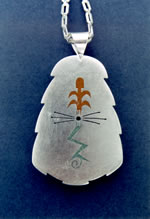 The
ceremonies rejuvenate me and then the thoughts and ideas come.”
The
ceremonies rejuvenate me and then the thoughts and ideas come.”Along the way, Amelia did learn about an enamel and epoxy process for executing designs. With 200 pounds of sand leftover from her sand painting days, and her background in painting, she decided to put the process to work using metal and sand, and came up with her unique designs. She is now successfully in her third year of business with 1½ years on the internet and is becoming busier and busier. She participates in four to five shows across the country every year. And when I spoke to her, she was just preparing for her third year of the Indian Market at Eiteljorg Museum in Indianapolis, Indiana.
Amelia works on many custom orders from clientele who provide her with pictures of their favorite areas or places while on honeymoons, which she then incorporates into jewelry for them; not to mention the least of which might be wedding bands. The satin finish process of raising fine silver to the surface, so characteristic of her work is much less messy than the polishing technique and doesn’t require machinery. Of this process, her parents say ‘that’s how it was done a long time ago’ in the early 1900’s before machinery was available.
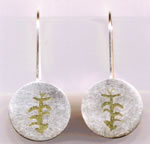 Although
Amelia is a successful artist and business person, she says she
will never fully leave teaching. She loves it and it’s part
of who she is. She has already taught an art appreciation class
for non majors at CEU here in Moab. She continues to teach a 5 day
intensive metal smithing class every year at Eagle Rock Alternative
Education School in Estes Park, Colorado.
Although
Amelia is a successful artist and business person, she says she
will never fully leave teaching. She loves it and it’s part
of who she is. She has already taught an art appreciation class
for non majors at CEU here in Moab. She continues to teach a 5 day
intensive metal smithing class every year at Eagle Rock Alternative
Education School in Estes Park, Colorado. Amelia’s personal assessment of her art is summed up in her artist’s statement, “The Diné (Navajo) Philosophy of Life encompasses air, fire, water, and earth which are worked into my pieces. The four cardinal directions, the four sacred colors, the four sacred plants, and the four sacred mountains are an integral part of my thoughts and processes in my designs. The symbolic representation of these elements appear as negative space, line, shape, color, and texture on silver, copper, and gold. These elements of nature, life giving sources, however, will not be shown together on one whole piece. Today, it is not wise to say too much or show too much. To “walk in beauty” (Hózhó), as I have learned, is not easy when one leaves footprints on both the reservation land of the Navajo Nation and the open land of America.”
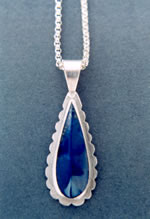 Moab
is very fortunate to have someone as talented and artistic as Amelia
Joe-Chandler. She is currently getting set up to be able to teach
out of her studio at home. If you are interested in future classes,
you can contact Amelia Joe-Chandler at 259-4543 or email her at:
joechandlerjewelry@navajo-art.com; or visit her website: www.navajo-art.com.
Moab
is very fortunate to have someone as talented and artistic as Amelia
Joe-Chandler. She is currently getting set up to be able to teach
out of her studio at home. If you are interested in future classes,
you can contact Amelia Joe-Chandler at 259-4543 or email her at:
joechandlerjewelry@navajo-art.com; or visit her website: www.navajo-art.com.
© 2001 Moab Happenings. All rights reserved. Reproduction of information contained in this site is expressly prohibited.
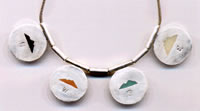 ARTIST
OF THE MONTH
ARTIST
OF THE MONTH 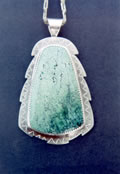 Though
Amelia was born in Evanston, Wyoming, she was raised on the Navajo
reservation in Northern New Mexico, and has her own long line of
credits and accomplishments.
Though
Amelia was born in Evanston, Wyoming, she was raised on the Navajo
reservation in Northern New Mexico, and has her own long line of
credits and accomplishments.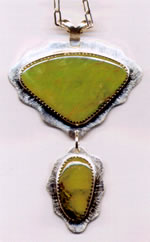 Amelia
assumed an adult money making role at an early age. She sold sand
paintings at 12 years old to trading posts and at 16 she struck
out on her own. At 18 she entered college with some scholarship
funds from her tribe and some from art guilds. She subsidized herself
through college by relying on the sales of her sand paintings. Amelia
was advised, as many are, to go into art education since that would
be the best reliable income when she graduated.
Amelia
assumed an adult money making role at an early age. She sold sand
paintings at 12 years old to trading posts and at 16 she struck
out on her own. At 18 she entered college with some scholarship
funds from her tribe and some from art guilds. She subsidized herself
through college by relying on the sales of her sand paintings. Amelia
was advised, as many are, to go into art education since that would
be the best reliable income when she graduated.